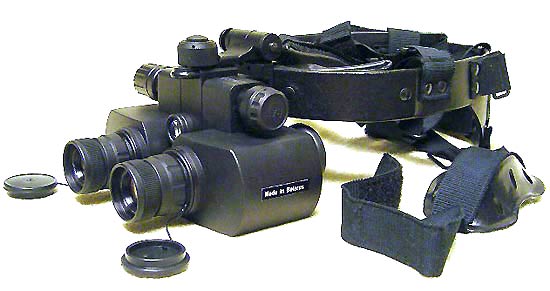I use my Dipol-2MB Night Vision Goggles only in emergency situations such as getting lost in a dense forest at night. This is a simple device of the 1st Generation, which can help you get through the woods and back to civilization in total darkness. That is why I think that Night Vision Goggles are the must if you plan to do a lot of hiking from remote sites at the end of your detecting day.
I do not use my night vision goggles while digging targets because of a simple inconvenience of refocusing the eyepiece diopters every time I have to retrieve a target. In order to see the objects on the ground up close while digging, one has to manually adjust the focus of the objective lenses, but when the viewing distance increases (when one stands up and begins to detect), the focus has to be changed back to previous setting. This procedure cuts metal detecting time considerably and causes only discomfort during the hunt. That is why I use a head-lamp when I metal detect at night.
Night Vision Goggles Dipol-2MB Specifications:
- Generation: 1st
- Focal length of objective lens, mm: 26/1.4
- Magnification: x1
- Angular field of view, degree: 37°
- Min. focus range, m: 0,25 ... infinity
- Eyepiece diopter adjustment range: ±5
- Battery: 2 x AA
- Battery Life: 24 hours
- Dimensions, mm: 137 x 153 x 81
- Weight, kg: 0.68
- Manufactured in Byelorussia
A few times, I got carried away with metal detecting at the remote "fruitful" site in dense forest. Every time I stayed there until the last minute of daylight; thus, missing my last opportunity to hike back to civilization without a problem. Before I started using the night vision goggles, I had to walk through pitch-black darkness as if I was completely blind, holding my shovel in front of my face to protect it from tree branches hanging over the path, and "seeing" the trail by my feet.
It would be easier if I had a flashlight or a head-lamp, but they would not allow me to see far ahead - still a great chance to get lost! The Night Vision Goggles turned out to be the best solution to the problem as they would provide me with visibility of a greater distance.
Night Vision Goggles are designed for observation in dim light under natural moon- or star-light illumination or even in full darkness using the build-in IR illuminator. The goggles are fixed on a user's head by means of special mask or helmet mount.

Night Vision Goggles Dipol-2MB with a Head-Mount
Here is How the Night Vision Devices Work:
Night vision devices (NVD), such as night vision goggles, night vision binoculars, night vision spotting scopes and night vision rifle scopes, gather existing ambient light (starlight, moonlight or infra-red light) through the front lens. This light, which is made up of photons goes into a photo cathode tube that changes the photons to electrons. The electrons are then amplified to a much greater number through an electrical and chemical process. The electrons are then hurled against a phosphorus screen that changes the amplified electrons back into visible light that you see through the eyepiece. The image will now be a clear green-hued amplified re-creation of the scene you were observing.
All Starlight scopes need some light to amplify. This means that if you were in complete darkness you could not see. To avoid this problem, there is a built-in, infra-red illuminator (IRI) on most NV devices. Basically what an IRI does is throw out a beam of infra-red light that is near invisible to the human eye but your NVD can see it. This allows you to use your scope even in total darkness. The IRI works like a flashlight and the distance you can see with it will be limited, out to 100 yards, basically 40-60% of the viewing area.
Four Generations of NVD's
A Night Vision Device can be either a 1st, 2nd, 3rd or 4th generation unit. What this stands for is what type of the light intensifier tube is used for that particular device. The light intensifier tube is the heart and soul of any NVD.
- The 1st Generation night vision devices are the cheapest type and still used for hunting, hiking, boating, observing wildlife, and other outdoor activities including metal detecting, or providing home security. Utilizing the basic principles described earlier, the 1st generation NVD will amplify the existing light several thousand times letting you clearly see in the dark. These units provide a bright and sharp image at a low cost.
- 2nd Generation is primarily used by law enforcement or for other professional applications. The 2nd gen units cost approximately $500.00 to $1000.00 more then the 1st gen devices. The main difference between the 1st and the 2nd generation is the addition of a micro-channel plate, commonly referred to as a MCP.
The MCP works as an electron amplifier and is placed directly behind the photo cathode. The MCP consists of millions of short parallel glass tubes. When the electrons pass through these short tubes, thousands more electrons are released. This extra process allows 2nd generation units to amplify the light many more times then 1st generation giving you a brighter and sharper image. - 3rd Generation - by adding a sensitive chemical, gallium arsenide, to the photo cathode, a brighter and sharper image was achieved. An ion barrier film was also added to increase tube life. 3rd Generation provides the user with good to excellent low light performance.
- 4th generation/Gated Filmless Tubes technology represents the biggest technological breakthrough in image intensification of the past 10 years. By removing the ion barrier film and "Gating" the system, Gen 4 demonstrates substantial increases in target detection range and resolution, particularly at extremely low light levels.